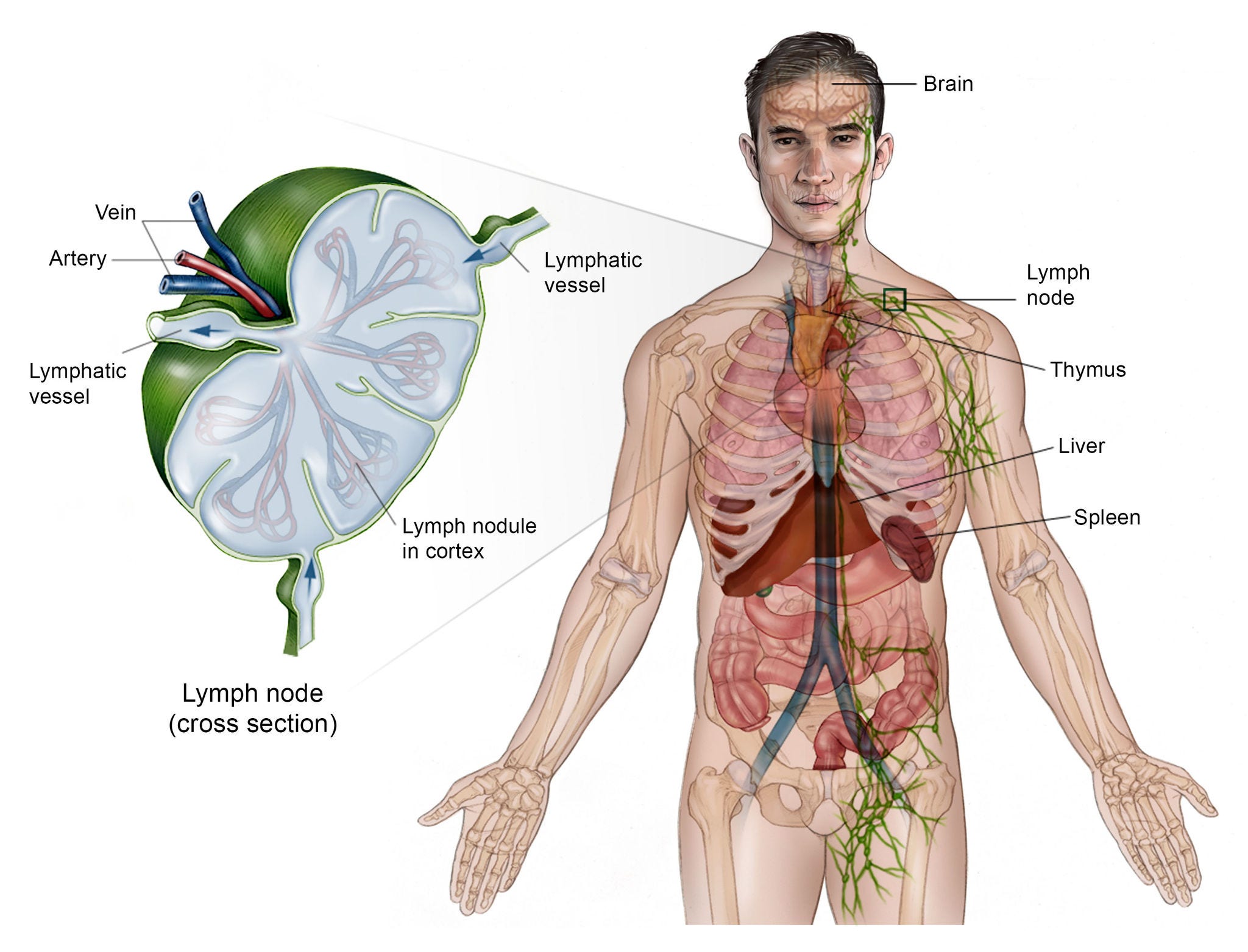Your gift is 100% tax deductible
What Is Non-Hodgkin Lymphoma?
Non-Hodgkin lymphoma (also known as non-Hodgkin’s lymphoma, NHL, or sometimes just lymphoma) is a cancer that starts in white blood cells called lymphocytes, which are part of the body’s immune system.
- NHL is a term that's used for many different types of lymphoma that all share some of the same traits. There is another main type of lymphoma, called Hodgkin lymphoma, which is treated differently. See Hodgkin Lymphoma.
- NHL most often affects adults, but children can get it too. See Non-Hodgkin Lymphoma in Children.
- NHL usually starts in lymph nodes or other lymph tissue, but it can sometimes affect the skin. See Lymphoma of the Skin.
Where lymphoma starts
Lymphoma starts in the body’s lymph system (also known as the lymphatic system). The lymph system is part of the immune system, which helps fight infections and some other diseases. It also helps fluids move through the body.
Lymphomas can start anywhere in the body where lymph tissue is found. The major sites of lymph tissue are:
- Lymph nodes: Lymph nodes are bean-sized collections of lymphocytes and other immune system cells throughout the body, including inside the chest, abdomen, and pelvis. They are connected by a system of lymphatic vessels.
- Spleen: The spleen is an organ under the lower ribs on the left side of the body. The spleen makes lymphocytes and other immune system cells. It also stores healthy blood cells and filters out damaged blood cells, bacteria, and cell waste.
- Bone marrow: The bone marrow is the spongy tissue inside certain bones. This is where new blood cells (including some lymphocytes) are made.
- Thymus: The thymus is a small organ behind the upper part of the breastbone and in front of the heart. It’s important in the development of T lymphocytes.
- Adenoids and tonsils: These are collections of lymph tissue in the back of the throat. They help make antibodies (disease-fighting proteins) against germs that are breathed in or swallowed.
- Digestive tract: The stomach, intestines, and many other organs also have lymph tissue.

© American Society for Clinical Oncology. Used with permission.
Types of non-Hodgkin lymphoma
Treatment for NHL depends on which type it is, so it’s important for doctors to find out the exact type of lymphoma you have. The type of lymphoma depends on what type of lymphocyte is affected (B cells or T cells), how mature the cells are when they become cancerous, and other factors.
B-cell versus T-cell lymphomas
The lymph system is made up mainly of lymphocytes, a type of white blood cell that helps the body fight infections. There are 2 main types of lymphocytes:
- B lymphocytes (B cells): B cells normally help protect the body against germs (bacteria or viruses) by making proteins called antibodies. The antibodies attach to the germs, marking them for destruction by other parts of the immune system.
- T lymphocytes (T cells): There are several types of T cells. Some T cells destroy germs or abnormal cells in the body. Other T cells help boost or slow the activity of other immune system cells.
Lymphoma can start in either type of lymphocytes, but B-cell lymphomas are most common.
Indolent versus aggressive lymphomas
Types of NHL can also be grouped based on how fast they grow and spread:
- Indolent lymphomas grow and spread slowly. Some indolent lymphomas might not need to be treated right away but can be watched closely instead. The most common type of indolent lymphoma in the United States is follicular lymphoma.
- Aggressive lymphomas grow and spread quickly. They usually need to be treated right away. The most common type of aggressive lymphoma in the United States is diffuse large B cell lymphoma (DLBCL).
- Some types of lymphoma, like mantle cell lymphoma, don’t fit neatly into either of these groups.
Regardless of how quickly they grow, all non-Hodgkin lymphomas can spread to other parts of the lymph system if not treated. Eventually, they can also spread to other parts of the body, such as the liver, brain, or bone marrow.
Classifying types of NHL
There are many types of non-Hodgkin lymphoma (NHL), so classifying them can be quite confusing (even for doctors). Several different systems have been used, but the most recent system is the World Health Organization (WHO) classification. The WHO system groups lymphomas based on:
- The type of lymphocyte (B-cell, T-cell, or other) the lymphoma starts in
- How the lymphoma looks under a microscope
- The chromosome features of the lymphoma cells
- The presence of certain proteins on the surface of the cancer cells
To learn more, see Types of B-cell Lymphoma and Types of T-cell Lymphoma
- Written by
- References

The American Cancer Society medical and editorial content team
Our team is made up of doctors and oncology certified nurses with deep knowledge of cancer care as well as editors and translators with extensive experience in medical writing.
Freedman AS, Freidberg JW, Aster JC. Clinical presentation and initial evaluation of non-Hodgkin lymphoma. In: Post T, ed. Uptodate. UpToDate; 2022. Accessed September 13, 2023.
Lewis, WD, Seth, L, Jones, KL. Lymphoma: diagnosis and treatment. Am Fam Physician. 2020;101(1):34-41.
Last Revised: February 15, 2024
American Cancer Society medical information is copyrighted material. For reprint requests, please see our Content Usage Policy.
American Cancer Society Emails
Sign up to stay up-to-date with news, valuable information, and ways to get involved with the American Cancer Society.



